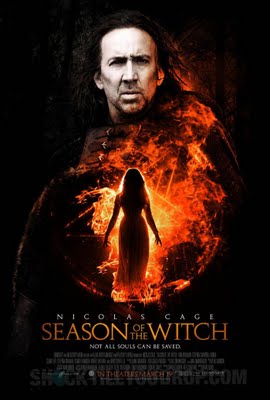
SEASON OF THE WITCH
US, 2011, 95 minutes, Colour.
Nicolas Cage, Ron Perlman, Stephen Campbell Moore, Stephen Graham, Ulrich Thomsen, Claire Foy, Robert Sheehan, Christopher Lee.
Directed by Dominic Sena.
Back to the Middle Ages. We might never have expected to see Nicolas Cage there, but sure enough, he is a crusader serving God by sending as many infidels to the other place as he can. We have seen Ron Perlman in the Middle Ages, in The Name of the Rose (with which this film has some similarities of plot, monasteries and manuscripts) and here he is again, ditto re crusading and dispatching the enemy. While Cage and Perlman are in the 14th century, they have disconcertingly out of place 21st century American accents and slang. Even British actors, Stephen Campbell Moore and Stephen Graham, have some American twanging.
But, this is one of those medieval adventures which rely on ecclesiastical gobbledigook, the execution of witches (hanging here), Latin incantations to break spells and illuminated manuscripts which demons want to destroy (before the prayers destroy them).
After the death of the witches, we are treated to some computer generated computer battles, all in the name of the Church, which Cage and Perlman rebel against after the deaths of women and children. They go AWOL. But, this leads them to a village where the population is dying of the plague, especially, the Cardinal leader (Christopher Lee under same large boils make-up). The only solution seems to be taking a witch to a monastery in the mountains and find the last remaining copy of the book with the spell-breaking prayers.
This leads to something of a medieval road movie, foggy forests, attacks by wolves with supernatural teeth and jaws and, quite excitingly, having to get horses, knights and a wagon with the witch, across a long rotting bridge across one of the deepest chasms you have seen.
The finale is a battle against the demon who had possessed the alleged witch and the bodies of the dead monks in the scriptorium were busy speedily copying the precious manuscript.
Director Dominic Sena had worked with Nicolas Cage in Gone in Sixty Seconds and is more at home in contemporary dramas, Kalifornia, Swordfish, Whiteout. They all don’t seem to be quite at home in the 14th century, which means that the film is something of a tongue-in-cheek costume time-passer.
1. A mediaeval caper? The blend of the serious and the light?
2. Historical hokum, witches and curses, witches rising, manuscripts and prayers, plague and the curse of demons, the confrontation with demons?
3. The prologue with the witches, the three witches and the accusations, their plea, the hanging, the priest and his dragging the witches from the river, his failed attempt with the last witch, her overcoming him, his attempts at prayers – and the attack of the demons?
4. Behman and Felson, Nicolas Cage and Ron Perlman as a mediaeval pair, the persona of each, the 21st century language, American accents and attitudes? At home in the Middle Ages or not? As crusaders, the collage of the battles and the CGI effects, the slaughters, each betting who would kill more, the drinks for the winner of the bet? The dates and places of the battles, the years passing? The effect of the massacre on women and children, the woman’s death in slow motion and the confrontation with Behman?
5. The leader of the crusade, God and the church, Behman denouncing this kind of behaviour by the crusaders, in the name of God? He and Felson going AWOL?
6. Their meandering through the mountains, their friendship and talk, retirement, their hopes, the approaching village, deciding to bypass it?
7. The empty village, people coming out to bury the dead victims, the revelation of the plague? The cardinal, his control of the village, his own illness, Christopher Lee and the makeup, Christopher Lee’s voice? The curse of the demon? The military commander, his attitude, encounter with the knights? The priest and his role in the household? Hagamar and his military role? Kay and his being the young trainee?
8. The beliefs about the witches, the torturing of the witches, the death of the commander, the cardinal giving the knights the mission, to take the possessed girl to the monastery? The deaths?
9. Behman and Felson and the new journey, the priest and his earnestness, religious language, accompanying the group? Kay and his help, earnest as well but naïve? Hagamar and his attitudes? The young woman, witch or not, being transported in the wagon? Open, covered?
10. The journey, the trek through the forests, the long sequence of crossing the bridge, the dangers, the excitement? The wolves and their appearance, the deaths – Hagamar?
11. The arrival at the monastery, the monks absent, finding them dead in the chapel, going to the scriptorium? Their being at work on copying the manuscript?
12. The witch and her being transformed into the gigantic demon, the monks being possessed and coming alive, Behman and Felson and the confrontation with the demons? Felson and his nonchalant attitude, giving his life? The priest, the combat, his death? Kay and his help? Behman and the final confrontation with the demon? The last copy of the manuscript, the monk and his reciting the prayer? The vanquishing of the demon?
13. The end, the demon destroyed, peace restored, Kay and the girl going back to the village? The girl restored and her not having any memories of what had happened when she was possessed by the demon?